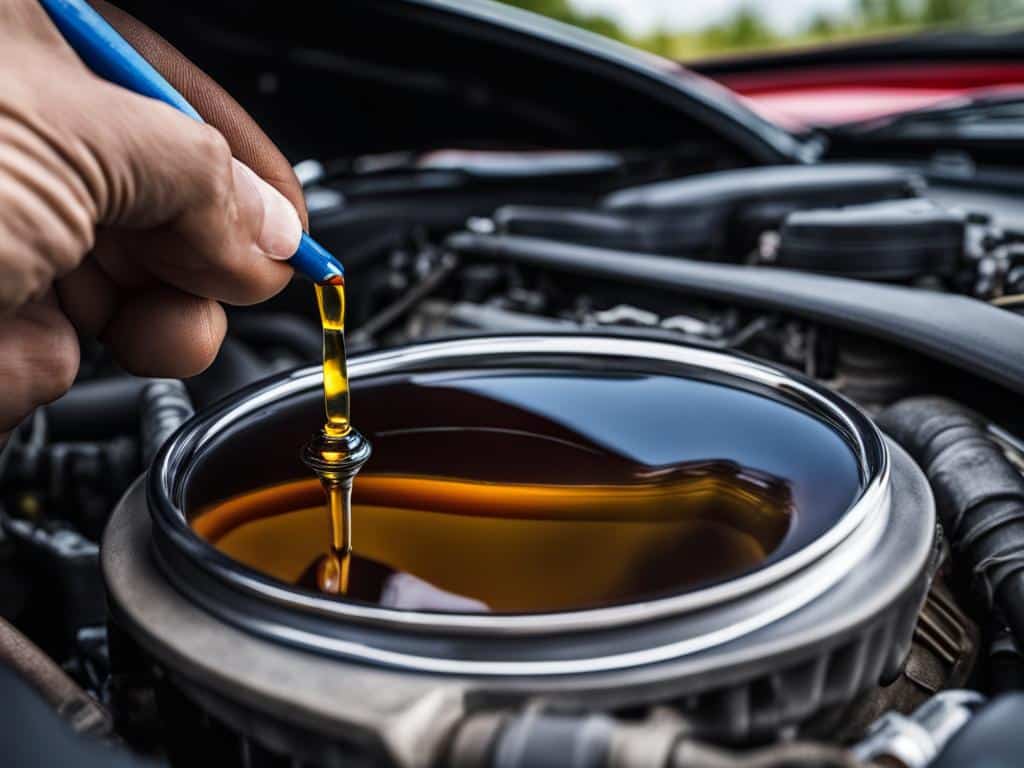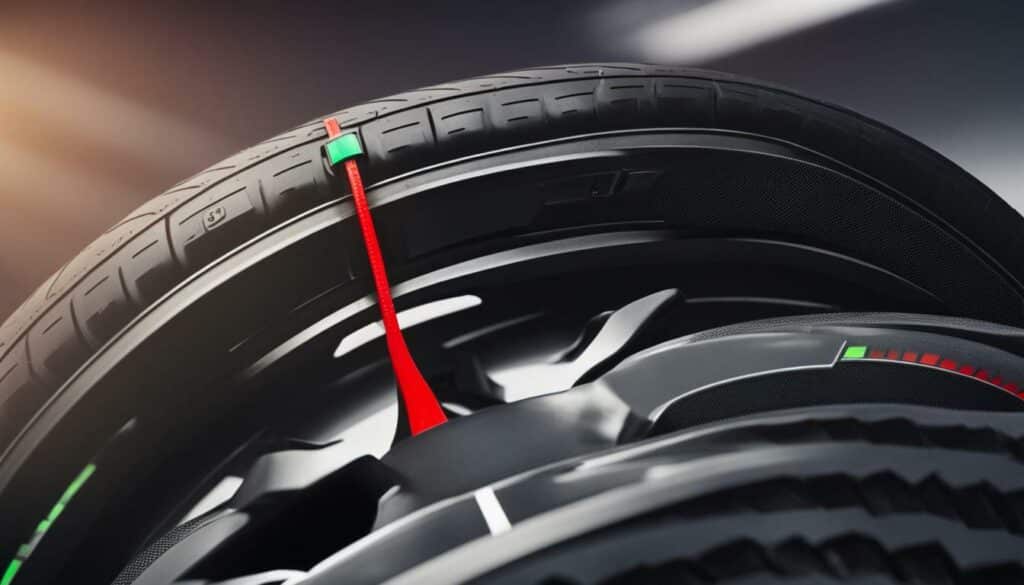Regularly checking and changing your engine oil is vital to keeping your car in running order. Engine oil lubricates, cleans, and protects internal parts from corrosion. It helps regulate engine temperature. Old, dirty oil can lead to poor engine performance, decreased fuel economy, and even engine damage. The time interval between oil changes in road vehicles has increased, with some newer cars requiring synthetic oil and longer change intervals. Your owner’s manual and driving habits should be considered when determining how often to change your oil. Checking your oil regularly and monitoring its quality and quantity is crucial for proper car maintenance.
Why Regularly Changing Your Engine Oil is Important
The importance of regularly changing your engine oil cannot be overstated. Engine oil plays a crucial role in lubricating, cleaning, and protecting the internal parts of your car’s engine. Over time, however, oil deteriorates, losing its lubricating qualities and becoming less effective at regulating engine temperature. This can lead to poor engine performance, decreased fuel economy, and even engine damage.
One of the main reasons why changing your engine oil is important is because oil picks up contaminants as it flows through the engine. These contaminants include metal particles, soot, dust, and fuel impurities. As these contaminants accumulate in the oil, they can diminish its lubricating properties and cause wear and tear on engine parts. Additionally, the additives in the oil that prevent corrosion and oxidation degrade over time.
The effects of old and dirty oil can be detrimental to your car’s engine. Regularly changing your engine oil not only ensures the proper functioning of the engine but also saves you money on fuel and helps reduce emissions.
By regularly changing your engine oil, you can ensure that your engine operates at its optimum level and remains protected from damage. It is recommended to follow the manufacturer’s guidelines for oil change intervals and consider factors such as driving habits, the type of oil used, and the conditions in which you drive. Regular oil changes are a small investment that can go a long way in maintaining the performance and longevity of your vehicle.
Consequences of Not Changing Your Engine Oil
Not changing your engine oil can have severe consequences for your car’s performance and longevity. The engine oil in your car plays a crucial role in lubricating, cleaning, and protecting the internal parts of the engine. Over time, the oil deteriorates, losing its lubricating qualities and becoming less effective at regulating engine temperature. This can lead to overheating, excessive wear on engine components, and potential engine damage.
One of the major risks of not changing your engine oil is the potential voiding of your car’s warranty. Many manufacturers require regular oil changes as part of their warranty terms. If you fail to adhere to these requirements, you may lose your warranty coverage, leaving you responsible for any costly repairs that may arise.
Furthermore, old and dirty engine oil contains contaminants, such as metal particles, dirt, and fuel impurities. These contaminants can accumulate and cause increased friction and wear on engine parts. Over time, this can lead to decreased engine performance, reduced fuel economy, and even engine failure.
Ultimately, neglecting to change your engine oil regularly is a small cost-saving measure that can result in significant expenses down the line. By following the recommended oil change intervals specified by your car’s manufacturer, you can help ensure the longevity and optimal performance of your engine.
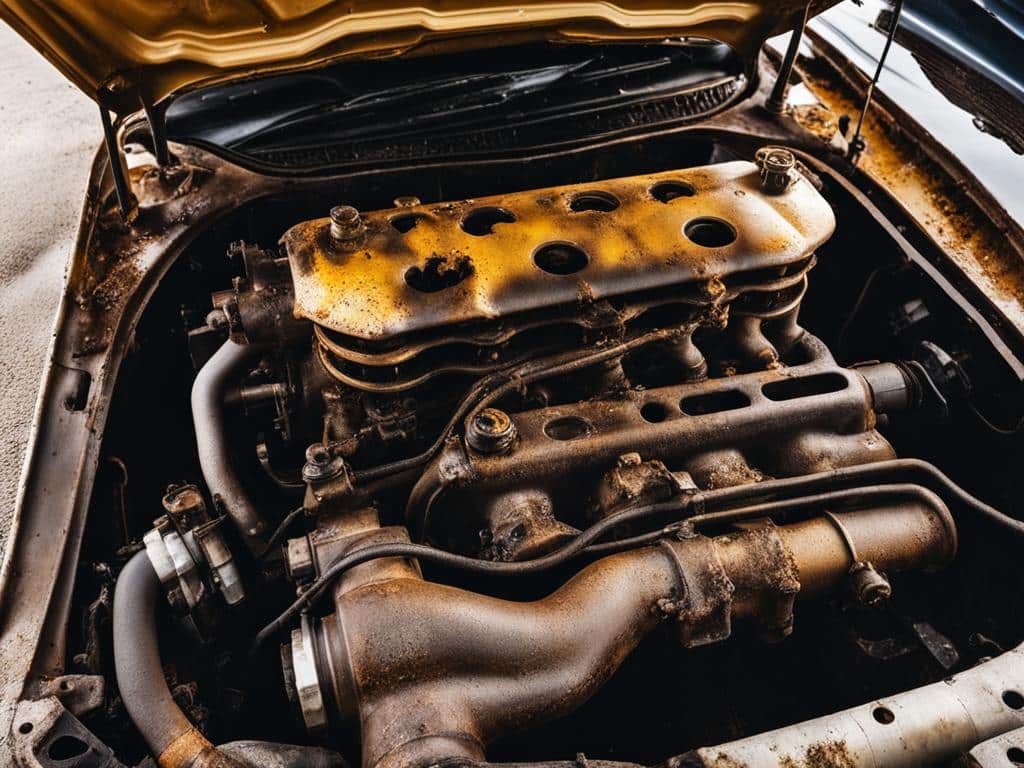
Table: Potential Consequences of Not Changing Engine Oil
| Consequence | Description |
|---|---|
| Engine Damage | Old and dirty oil can lead to increased friction and wear on engine parts, potentially causing irreversible damage and the need for costly repairs. |
| Poor Engine Performance | Dirty oil can negatively impact the performance of your engine, resulting in decreased power, lower fuel efficiency, and sluggish acceleration. |
| Decreased Fuel Economy | Old oil can lead to increased engine friction and less efficient combustion, resulting in higher fuel consumption and reduced mileage. |
| Overheating | Inadequate lubrication and temperature regulation due to old oil can lead to engine overheating, potentially causing severe damage and the need for repairs. |
| Void Warranty | Failure to adhere to recommended oil change intervals can void your car’s warranty, leaving you responsible for any repairs and costs. |
“Regular oil changes are a small cost compared to the potential expenses and inconvenience of engine repairs or replacement.”
– Car Maintenance Expert
Recommended Oil Change Intervals
When it comes to how often you should change your engine oil, several factors come into play. Manufacturers’ recommendations, the performance level of the oil, driving style, type of route, external conditions, and annual mileage all play a role in determining the ideal oil change interval. It’s crucial to consult your owner’s manual for specific recommendations as each car may have different requirements.
Newer cars that use synthetic or synthetic-blend oils generally have longer oil change intervals compared to older models that use conventional oil. Synthetic oils have superior durability and can withstand higher temperatures, which means they remain effective for a longer period. On the other hand, conventional oils may require more frequent changes. Additionally, the driving habits and conditions can impact the frequency of oil changes. Short trips in stop-and-go traffic or towing heavy loads can put more strain on the engine and may require more frequent oil changes.
Some cars are equipped with oil sensors that monitor the oil’s life and provide recommendations on when to change it. These sensors consider factors like engine temperature, driving conditions, and oil quality to determine the optimal time for an oil change. It’s important to follow the manufacturer’s maintenance schedule and heed the recommendations provided by these sensors to ensure proper engine function and maintain warranty coverage.
| Driving Habits | Oil Change Interval |
|---|---|
| Normal driving conditions, moderate trips | Every 5,000 to 7,500 miles (8,000 to 12,000 kilometers) or every 6 months |
| Severe driving conditions, short trips, stop-and-go traffic, extreme temperatures | Every 3,000 to 5,000 miles (4,800 to 8,000 kilometers) or every 3 months |
| High-performance vehicles, heavy towing, racing | Every 2,000 to 3,000 miles (3,200 to 4,800 kilometers) or every 2 months |
Ultimately, following the recommended oil change intervals and regularly checking your oil’s quality and level are essential for maintaining your car’s performance and longevity. By adhering to the manufacturer’s guidelines and considering your driving habits, you can ensure that your engine stays properly lubricated and protected.
Signs It’s Time to Change Your Engine Oil
Regularly monitoring your engine oil is crucial for maintaining the health and performance of your car. By paying attention to certain signs, you can determine when it’s time to change your engine oil. Here are some indicators that it may be time for an oil change:
- Oil texture: Check the oil’s color and texture. If it appears opaque, granular, black, milky, runny, or gritty, it’s an indication that the oil needs to be changed.
- Strange engine sounds: Listen for any ticking sounds when starting your car or rattling and shaking while idling. These noises may be a sign of degraded engine oil and the need for an oil change.
- Excessive smoke from the exhaust: If you notice blue or grey smoke coming from your exhaust, it could indicate an oil leak and the need for an oil change.
- Unusual odors: Pay attention to any unusual odors inside your car, such as the smell of motor oil or gasoline. These odors may indicate oil leakage or overheating, signaling the need for an oil change.
Regularly checking these signs can help you determine when it’s time to change your engine oil. By addressing oil change needs promptly, you can ensure the optimal performance and longevity of your car.
Remember, prevention is better than cure when it comes to maintaining your car. Regularly checking your engine oil and changing it when necessary can help you avoid costly repairs and keep your car running smoothly.
| Signs It’s Time to Change Your Engine Oil | Actions to Take |
|---|---|
| Oil texture appears opaque, granular, black, milky, runny, or gritty | Schedule an oil change as soon as possible |
| Strange engine sounds like ticking, rattling, or shaking while idling | Consult a mechanic and consider an oil change |
| Excessive smoke from the exhaust (blue or grey) | Have your car inspected for oil leaks and consider an oil change |
| Unusual odors of motor oil or gasoline inside the car | Check for oil leakage and consider an oil change |
By being attentive to these signs and taking appropriate action, you can ensure that your engine remains well-lubricated and protected, maximizing the performance and longevity of your vehicle.
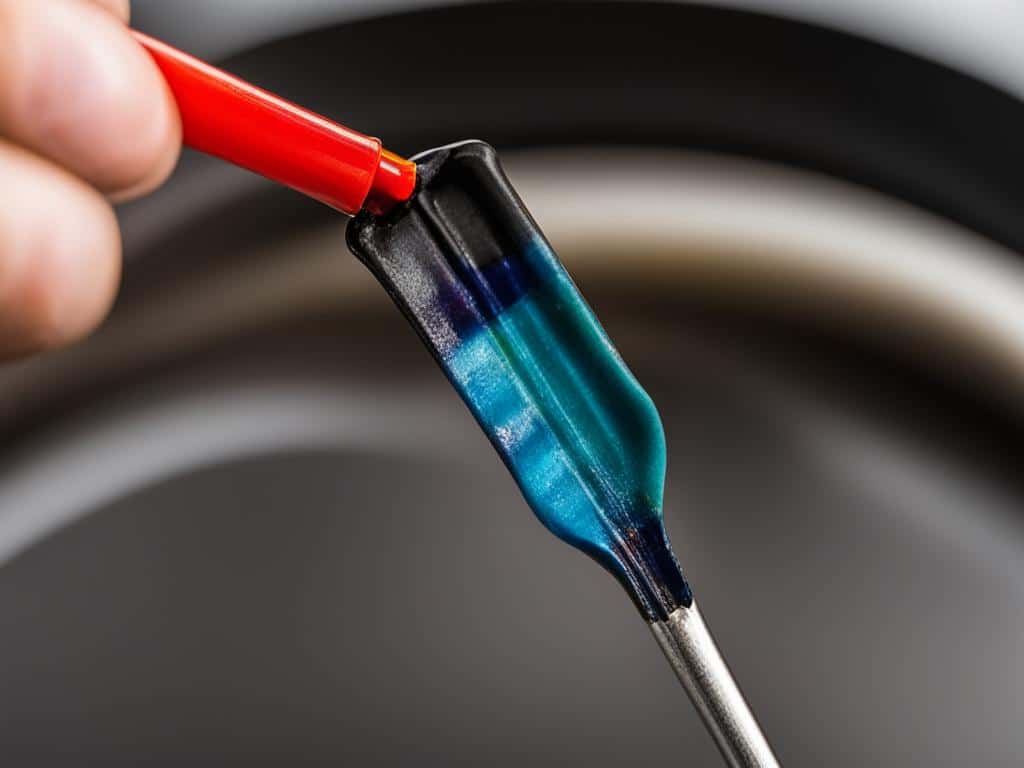
How to Check Your Engine Oil
Checking your engine oil is an important part of regular car maintenance. By monitoring the quality and quantity of your oil, you can ensure that your engine is running smoothly and avoid potential problems down the line. Here’s a step-by-step guide on how to check your engine oil:
- Park on level ground: To get an accurate reading, make sure your car is parked on a flat surface.
- Let the engine cool down: Wait for about 10 to 15 minutes after turning off the engine to allow the oil to settle.
- Open the hood: Locate the hood release lever inside your car and pull it to open the hood.
- Find the dipstick: The dipstick usually has a yellow or red handle and is located near the front of the engine.
- Remove and wipe the dipstick: Pull out the dipstick, wipe it clean with a cloth or paper towel, and then reinsert it back into its tube.
- Check the oil level: Pull out the dipstick again and examine the oil level. There are usually indicator marks labeled “Min” and “Max” on the dipstick. The oil level should be between these two marks.
- Inspect the oil color and texture: Take note of the oil’s color and consistency. It should be a clear, amber color and have a smooth texture. If the oil appears dirty, gritty, or has a milky appearance, it may be time for an oil change.
Regularly checking your engine oil is a simple task that can help you identify any potential issues early on and ensure the overall health of your car. Remember to consult your owner’s manual for specific instructions and recommendations regarding oil type and change intervals.
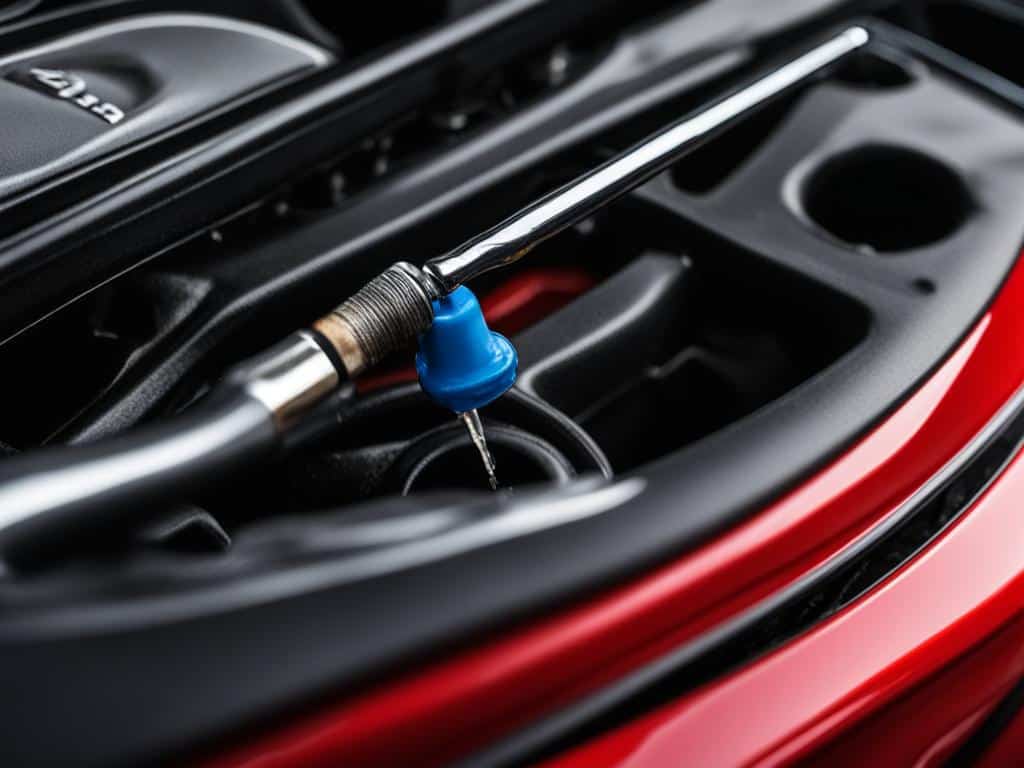
Why is Checking Your Engine Oil Important?
“Regularly checking your oil level and quality is crucial for maintaining an optimally functioning engine.”
Checking your engine oil allows you to keep track of its level and condition, which are vital for your car’s performance and longevity. Here are a few reasons why regularly checking your engine oil is important:
- Lubrication: Engine oil lubricates the moving parts of your engine, reducing friction and wear. Insufficient oil levels can lead to increased friction and potential engine damage.
- Cooling: Engine oil helps regulate the temperature of your engine by dissipating heat. Without proper oil levels, your engine may overheat and cause severe damage.
- Cleaning: Oil carries away dirt, debris, and contaminants from your engine. Over time, these impurities can accumulate and hinder engine performance.
- Early Problem Detection: By regularly checking your engine oil, you can catch any oil leaks, signs of contamination, or engine issues early on, allowing for timely repairs and preventing further damage.
Remember, a well-maintained engine is a key factor in ensuring the overall health and performance of your car. By incorporating regular oil checks into your maintenance routine, you can contribute to the longevity and reliability of your vehicle.
How Often to Check Your Engine Oil
Regularly checking your engine oil is an important part of car maintenance and can help ensure the optimal performance and longevity of your vehicle. By monitoring your engine oil regularly, you can catch any issues early and prevent costly repairs. Checking your engine oil is a simple and straightforward process that can be done in just a few minutes.
It is recommended to check your engine oil at least once a month or every couple of weeks. This frequency allows you to stay on top of any changes in oil quality and quantity, serving as indicators of your car’s overall health. By checking your oil regularly, you can identify any signs of contamination or degradation, such as a change in color or texture, which may require an oil change.
Regularly checking your engine oil is particularly important if you frequently drive under harsh conditions or have an older vehicle. These factors can accelerate oil degradation and increase the likelihood of engine issues. By staying proactive and monitoring your oil levels, you can address any potential problems before they become major repairs.
Remember, an ounce of prevention is worth a pound of cure. Regularly checking your engine oil can save you money in the long run and ensure your car’s optimal performance and longevity.
| Frequency | Action |
|---|---|
| Once a month | Check engine oil level and quality |
| Every couple of weeks | Monitor any changes in oil color or texture |
| After driving under harsh conditions | Check oil level and look for signs of contamination or degradation |
Regularly checking your engine oil is a simple step that can save you money in the long run and ensure your car’s optimal performance and longevity. It is an essential part of car maintenance and should be included in your regular routine. By staying proactive and monitoring your oil, you can catch any issues early and keep your car running smoothly.
How to Change Your Engine Oil
Changing your own engine oil is a rewarding and cost-effective way to maintain your car’s performance. By following a few simple steps, you can ensure that your engine is running smoothly and efficiently. Here’s a comprehensive guide to performing a DIY oil change:
Gather the necessary tools and materials:
- Oil – Check your owner’s manual for the recommended oil type and quantity.
- Oil filter – Make sure to get the correct filter for your car’s make and model.
- Replacement washer for the drain plug – This helps prevent leaks.
- Jack and jack stands (or ramps) – These are needed to lift your car safely.
- Wrench and oil filter wrench – These tools will help you remove the drain plug and oil filter.
- Oil drain pan – Use this to catch the old oil during the oil change.
- Latex gloves – Protect your hands from oil and dirt.
Once you have all the necessary tools and materials, follow these steps to change your engine oil:
- Park your car on level ground and let the engine cool down for about 10 to 15 minutes.
- Place the jack or ramps in the appropriate position to lift your car off the ground.
- Locate the oil drain plug underneath your car. Position the oil drain pan underneath the plug.
- Using a wrench, carefully loosen and remove the drain plug. Allow the old oil to drain completely into the pan.
- Once the oil has drained, replace the washer on the drain plug and securely screw it back into place.
- Locate the oil filter and use an oil filter wrench to remove it. Make sure to have the drain pan ready to catch any residual oil.
- Before installing the new oil filter, apply a thin layer of clean oil to the rubber gasket to ensure a proper seal.
- Install the new oil filter and tighten it by hand. Be careful not to overtighten.
- Add the recommended amount and type of fresh oil through the oil filler cap under the hood.
- Check the oil level using the dipstick. Add more oil if necessary to reach the correct level.
- Dispose of the old oil and oil filter properly at a recycling center or an auto parts store.
By following these steps, you can confidently change your own engine oil and save money on professional servicing. Remember to always refer to your owner’s manual for specific instructions and recommendations. Regular oil changes are essential for maintaining the health and longevity of your engine.
| DIY Oil Change Tips: |
|---|
| Be cautious when working with hot oil to avoid burns. Allow the engine to cool down before starting the oil change process. |
| Properly dispose of the used oil and oil filter. Many auto parts stores provide recycling services for used oil and filters. |
| Wear latex gloves to protect your hands from oil and dirt during the oil change. |
| Double-check the oil level using the dipstick after the oil change to ensure it is at the correct level. |
The Importance of Regular Vehicle Servicing
Regular vehicle servicing is not only essential for maintaining the health and performance of your car but also ensures your safety on the road. By following the manufacturer’s recommended service schedule and conducting comprehensive checks, you can prevent potential issues from escalating into costly repairs. Vehicle servicing encompasses various maintenance tasks, including engine oil and filter changes, tire rotations, brake inspections, and fluid top-ups.
One of the primary benefits of regular servicing is early problem detection. During a service, experienced technicians thoroughly inspect your car to identify any underlying issues that may not be apparent during regular use. By catching these problems early on, you can address them sooner, preventing further damage and reducing the risk of breakdowns or accidents.
Another advantage of regular vehicle servicing is the extension of your car’s lifespan. By keeping your car in optimal condition through regular maintenance, you can maximize its longevity and potential resale value. Regular servicing also helps maintain warranty coverage, providing you with additional peace of mind.
| Benefits of Regular Vehicle Servicing |
|---|
| Early problem detection |
| Prevention of costly repairs |
| Increased car lifespan |
| Maintained warranty coverage |
| Enhanced safety on the road |
Overall, regular vehicle servicing is a small investment that yields significant long-term benefits. It ensures your car operates at its best, extends its lifespan, and provides you with a reliable and safe mode of transportation. Don’t neglect the importance of servicing your car regularly and adhere to the recommended maintenance schedule.
The Importance of Car Safety
When it comes to vehicle maintenance, safety should always be a top priority. Regular servicing plays a crucial role in ensuring the safety of both you and your passengers. By regularly inspecting your car, technicians can identify potential safety hazards, such as faulty brakes, worn-out tires, or malfunctioning lights, and address them promptly. Regular servicing not only reduces the risk of accidents but also enhances your driving experience by providing you with peace of mind on the road.
Conclusion
To ensure your car’s optimal performance and longevity, it is crucial to prioritize regular car maintenance. By regularly changing your engine oil, you can protect your engine and maintain its performance. The frequency of oil changes depends on various factors, including manufacturer recommendations, driving habits, and environmental conditions. Following the recommended maintenance schedule and guidelines will help you determine the best intervals for oil changes.
Additionally, paying attention to signs that indicate it’s time to change your oil can prevent potential engine damage. Keep an eye out for changes in oil texture, strange engine sounds, excessive smoke from the exhaust, and unusual odors. Regularly checking your engine oil quality and quantity is simple yet essential for proper car maintenance.
While changing your own oil can save you money, it is important to ensure the job is done correctly. DIY oil changes require the proper equipment and following the specific steps outlined in your owner’s manual. If you’re unsure, it’s always best to consult a professional.
Lastly, don’t forget the importance of regular vehicle servicing. Alongside engine oil and filter changes, comprehensive checks conducted during servicing can save you from costly repairs. It also increases the resale value of your car and extends its lifespan. By prioritizing car maintenance and adhering to best practices, you can enjoy a smooth, safe, and trouble-free driving experience.
FAQ
How often should I change my engine oil?
The frequency of oil changes depends on several factors, including manufacturers’ recommendations, the performance level of the oil, driving style, type of route, external conditions, and annual mileage. It is best to consult your owner’s manual for specific recommendations.
What are the signs that it’s time to change my engine oil?
Signs that indicate it’s time to change your engine oil include the oil’s texture, strange engine sounds, excessive smoke from the exhaust, and odors of motor oil or gasoline inside the car. Regularly checking these signs can help you determine when it’s time for an oil change.
How do I check my engine oil?
Checking your engine oil is an easy process. Park your car on level ground, turn off the engine, and let it cool for 10 to 15 minutes. Open the hood and locate the dipstick, usually marked with a yellow or red tab. Remove the dipstick and examine the oil’s color and texture. Wipe the dipstick clean, reinsert it, then remove it again to check the oil level using the indicator marks. If the oil level is low, add small amounts of oil until it reaches the correct level.
How often should I check my engine oil?
It is good practice to check your engine oil at least once a month or every couple of weeks. Regularly checking your engine oil helps monitor its quality and quantity, serving as indicators of your car’s overall health.
Can I change my own engine oil?
Yes, changing your own engine oil is a relatively quick and easy task if you have the proper equipment. Before getting started, gather the necessary items, including oil, an oil filter, a replacement washer for the drain plug, a jack and jack stands (or ramps), a wrench, an oil filter wrench, an oil drain pan, and latex gloves. Follow the specific steps outlined in your owner’s manual. Changing your own oil can save you money and ensure the job is done correctly.
Why is regular vehicle servicing important?
Regular vehicle servicing, including engine oil and filter changes, is crucial for maintaining your car’s health and ensuring it runs smoothly, efficiently, and safely. Neglecting servicing can lead to larger bills in the future and potential dangers while driving. Following the manufacturer’s service schedule and considering comprehensive checks are essential for proper car maintenance and optimal performance.
